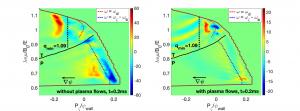Increasing fusion performance with energetic-particle-driven instabilities
New results published in Physical Review Letters suggest that instabilities driven by energetic particles can have a positive impact on fusion performance.
However, the presence of energetic particles can drive instabilities in the plasma core, such as the so-called "fishbone" instability that is named for the way it appears on the magnetic measurements (see Fig.1). If the amplitude of this instability is large enough, it can lead to a redistribution of energetic particles out of the plasma core, deteriorating the plasma's self-heating process.
Through an international collaboration involving researchers from the ITER Organization, the United States, France and China, scientists have shown for the first time that the amplitude of the fishbone instability can be significantly reduced by the self-generation of strong flows within the plasma (see Fig. 2). This research was carried out using state-of-the-art plasma simulation software developed at the University of California Irvine, the Princeton Plasma Physics Laboratory and the École Polytechnique in Paris. The simulations described an experimental plasma discharge from the DIII-D tokamak at General Atomics (San Diego, USA) that was chosen to capture the dynamics of energetic particles in ITER. This experiment featured a sharp increase of plasma performance during the excitation of fishbone instabilities.



